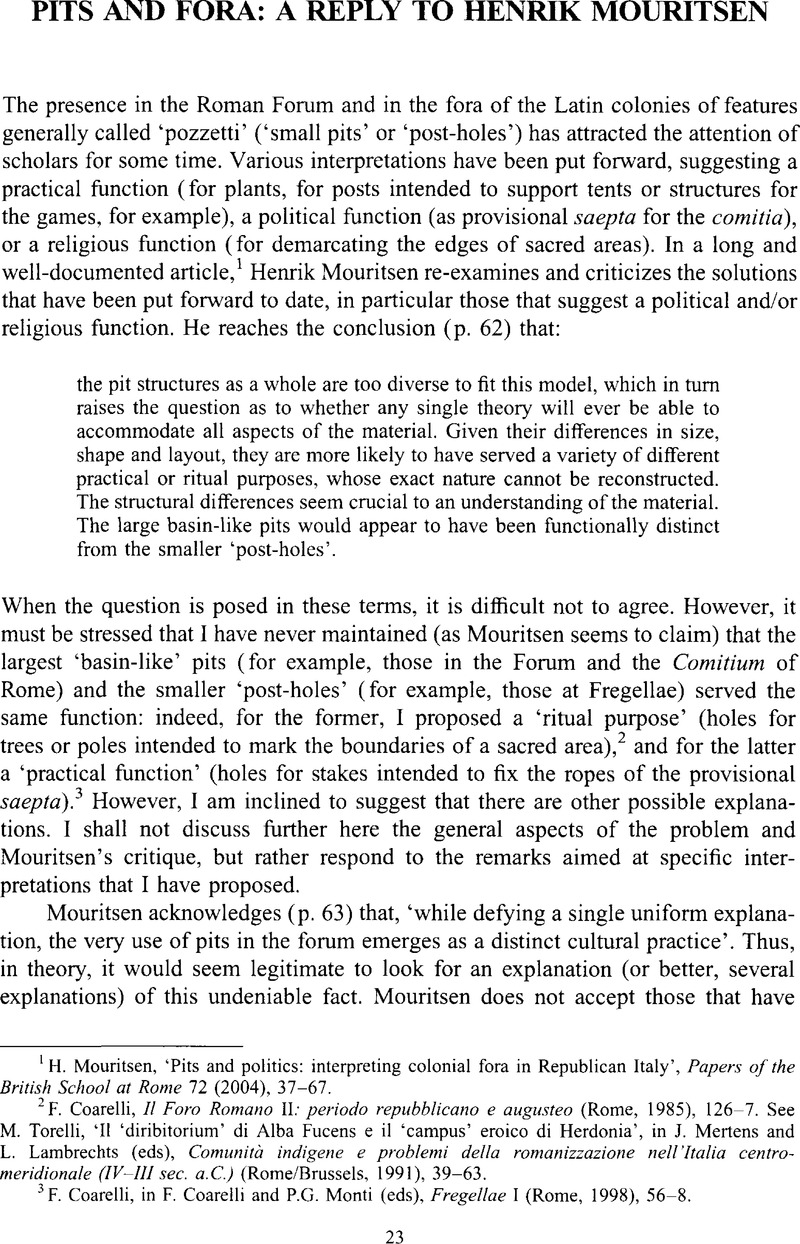Article contents
Pits and fora: a reply to Henrik Mouritsen
Published online by Cambridge University Press: 09 August 2013
Abstract

- Type
- Articles
- Information
- Copyright
- Copyright © British School at Rome 2005
References
1 Mouritsen, H., ‘Pits and politics: interpreting colonial fora in Republican Italy’, Papers of the British School at Rome 72 (2004), 37–67CrossRefGoogle Scholar.
2 Coarelli, F., Il Foro Romano II: periodo repubblicano e augusteo (Rome, 1985), 126–7Google Scholar. See M. Torelli, ‘Il ‘diribitorium’ di Alba Fucens e il ‘campus’ eroico di Herdonia’, in Mertens, J. and Lambrechts, L. (eds), Comunità indigene e problemi della romanizzazione nell'Italia centromeridionale (IV–III sec. a.C.) (Rome/Brussels, 1991), 39–63Google Scholar.
3 Coarelli, F., in Coarelli, F. and Monti, P.G. (eds), Fregellae I (Rome, 1998), 56–8Google Scholar.
4 Coarelli (above, n. 3), 34–7.
5 Livy 27.9.2ff.; 10.3ff.
6 Mouritsen, H., Italian Unification: a Study in Ancient and Modern Historiography (Bulletin of the Institute of Classical Studies Supplement 70) (London, 1998Google Scholar).
7 Coarelli, F., Il Foro Romano I: periodo arcaico (Rome, 1983), 119–60Google Scholar; Coarelli, , Il Foro Romano II (above, n. 2), 11–21Google Scholar.
8 Election of C. Gracchus: Plutarch, Gaius Gracchus 3.1. Taylor, L.R., Roman Voting Assemblies (Ann Arbor, 1966), 46–8, 79–83Google Scholar.
9 Fraccaro, P., ‘La procedura del voto nei comizi tributi romani’, Atti della Regia Accademia delle Scienze di Torino 49 (1913–1914), 600 ffGoogle Scholar. = Opuscula 2 (Pavia, 1957), 235–54Google Scholar.
10 Plebs, H. Mouritsenand Politics in the Late Roman Republic (Cambridge, 2001), 18ffGoogle Scholar.
11 Nicolet, C., Le métier de citoyen dans la Rome républicaine (Paris, 1976), 299–302Google Scholar.
12 Mouritsen, Plebs and Politics (above, n. 10), 26–30.
13 Coarelli (above, n. 3).
14 CIL IX 3513 = I2 756 = ILLRP 508. Laffi, U., ‘La lex aedis Furfensis’, in La cultura italica. Atti del convegno della Societá Italiana di Glottologia, Pisa, 19–20 Dicembre 1977 (Pisa, 1978), 121–44Google Scholar.
15 For Mouritsen, the closest comparison with these ‘basin-like pits’ (p. 62) is at the temple of Gabii, for which the only reference he cites is H. Lauter, ‘Ein Tempelgarten?’, Archäologischer Anzeiger (1968), 626–31. Mouritsen seems, therefore, to ignore the more recent studies of the argument, which have demonstrated that they are in fact holes for trees: Gorbea, M. Almagro (ed.), El Santuario de Juno en Gabii (Rome, 1982Google Scholar); Coarelli, F., I santuari del Lazio in età repubblicana (Rome, 1987); see also Les bois sacrés. Actes du colloque international organisé par le Centre Jean Bérard et l'École Pratique des Hautes Études (Ve section), Naples, 23–25 Novembre 1989 (Naples, 1993) — the contribution of J. Scheid on the sanctuary of Dea Dia is fundamental. If this comparison is valid, as Mouritsen believes, it represents a clear confirmation of the use of the pits in the forum as holes for treesGoogle Scholar.
- 3
- Cited by




